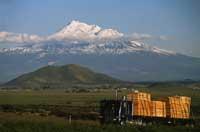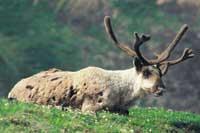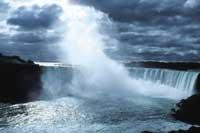One third of the world's threatened habitats
report "Global Warming and terrestrial Biodiversity Decline" published by WWF, a third of the planet's plant and animal species may disappear in the XXI. throughout the 20th century. Climate change will affect the biodiversity of the entire planet and especially the high latitudes of the Northern Hemisphere.
The habitats of the planet and the living beings that live under its protection are distributed geographically by climatic imperatives, among others. In fact, climate changes in the past have repeatedly altered the distribution of living things. For example, temperate climate trees migrated tens of meters along the annual Holocene, along with glaciers backing north. In the same way, if the greenhouse effect that we are living continues, similar processes will occur but in much less time than in the glacial era, since the current warming is the fastest of the last 100,000 years.

Of course, warming will alter habitats. Plants in a given region will change and with them animals. But how? At what speed? How much will be lost on the road? At the request of WWF, Jay R. Researchers Malcom and Adam Markham have tried to answer these questions based their research on the migratory capacity of living beings. The former is a professor at the University of Toronto and the latter is responsible for the US non-governmental organization Clean Air-Cool Planet.
The
study analyzed three variables that could threaten biodiversity: the ability of species to adjust migration speed to warming speed, loss of habitat associated with climate change and loss of biodiversity due to declining habitat affected region. Factors that in turn can hinder the migration of living things have also been considered: natural borders, such as oceans and lakes, and man-made borders, including cities and rural lands.
Researchers
have used 7 climate models and two biogeographic models to see how vegetation can change as a result of the greenhouse effect and predict the evolution of biodiversity.
Virtue agility

On a
rapidly warming planet, the fate of many species is conditioned by the ability to migrate to more favorable climatic situations. Unfortunately, the migration capacity of species is a variable that is not yet well understood, so it is difficult to estimate the severity of the possible climate change to biodiversity. In general, the data used by the researchers come from ancient fossil remains, mainly from reforestation after the last period of ice. As the climate warms up, the icy regions of the forests quickly filled. However, the differences in what happened are evident: for some it was the fastest migration speeds ever observed and for others, if necessary, some species might have the ability to move faster. However, the report that concerns us does not analyze the speed with which species and habitats can be mobilized, but rather the speed of migration that climate change will require.
To
do this, Jay R has calculated the required migration rates of all regions of the planet. Malcolm and Adam Markham. Speeds above one meter per year have been considered very high as they are scarce in fossil records. To calculate which species are sensitive to global warming, two measurements have been made: Computer models have calculated the effect of doubling carbon dioxide levels in the atmosphere in 100 years and 200 years. These periods are based on real data, the most affordable studies are also based on the XXI. By the mid-twentieth century they have announced a similar situation: The Earth's atmosphere will already have twice as much carbon dioxide as before industrialization and the XXI. In the twentieth century it may have tripled its number.
Disaster in the Northern Hemisphere
Jay R. The results of the research by Malcom and Adam Markham announce a dark future for plants and animals. In plants, both in the period of 100 years and in the period of 200, the necessary migration speeds announced by the models have been enormous, 10 times higher than those of the last glaciations. That's a lot, because post-glaciations are already considered extraordinary. If migration speeds are too high for plants, they will also be too large for animals living under their protection, as, despite moving faster, they will not find suitable habitats.

In the
broad regions of the Northern Hemisphere, especially in Canada, Russia and Scandinavia, the high migration speeds required (one meter per year) have been frequent in 60% of Finland, 38% of Russia and 33% of Canada. In Finland, in addition, due to the natural obstacle posed by the presence of the peninsula and the southern cities, there have been many times higher speeds measured.
Habitat
losses will also be important and, again, the most affected regions will be those in the northwest. Researchers have announced that more than 50% of their habitats are endangered. In the 20 countries with the most severe losses, Iraq will lose less habitat, 43%, and Iceland, 82%. In these 20 countries will disappear between 2.3% and 5.3% of species, but the most serious losses will occur in the Arctic and mountain regions, specifically between 6% and 20%.
In short, global warming will
prevent higher migration speeds than ever before to terrestrial animals and plants and although their migratory capabilities are not well known, it seems that demand will be excessive for many species. In cold-adapted regions, i.e. in arctic and alpin habitats, many migrated or non-migrated species will disappear.
An e-mail for nature

An important meeting on climate change will take place next November in The Hague, Netherlands. The signatory countries will agree on the latest rules for the implementation of the Kyoto Protocol approved in 1997. But, as is often the case, the great purposes prior to the beginning could go bankrupt after the meeting. Environmental organizations such as WWF, Geenpeace, Friends of the Earth have launched the web www.climatevoice.org to ask the world's political leaders not to miss the November meeting. To do this they want to send 10 million messages in the body that carry that request. The message can be sent by me, you or anyone else through the aforementioned website. At the corresponding polls simply enter the name, surname and email and click to send the message. A million have already been issued, but more is needed. One million messages per year of delay in taking action against the greenhouse effect. In fact, the United Nations climate change group published its first work on the greenhouse effect in 1990. Since then the gravity of the warming of the planet has been revealed, but 10 years later they have not yet caught the bull from the branches.
Published in the supplement Natura de Gara
...
Buletina
Bidali zure helbide elektronikoa eta jaso asteroko buletina zure sarrera-ontzian











